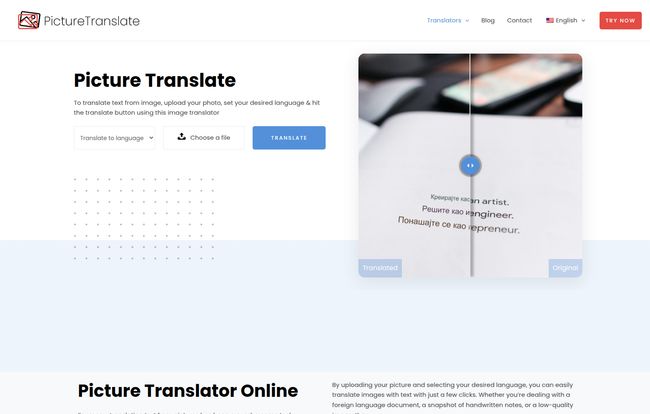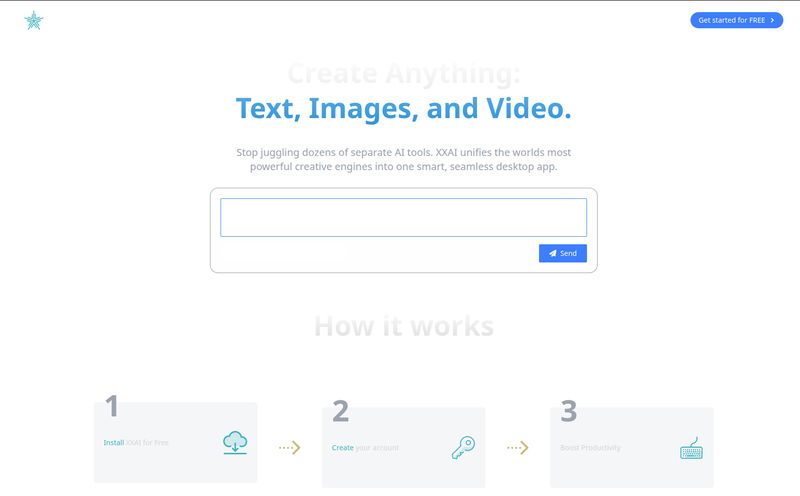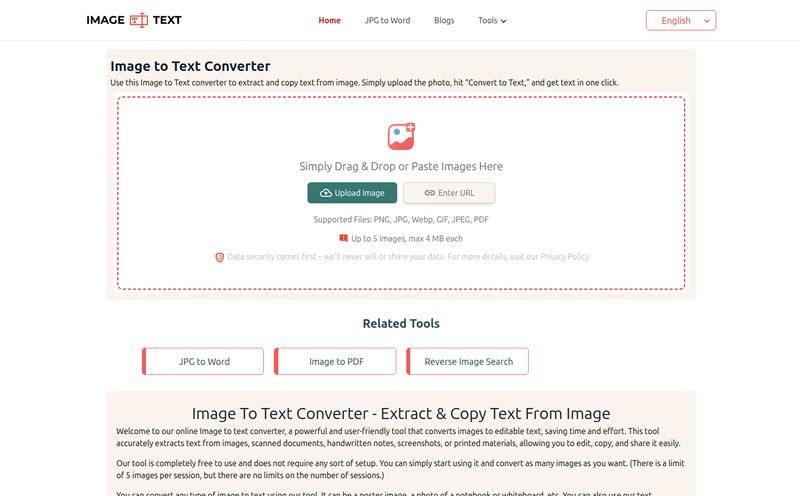We've all been there. You're scrolling through social media and see a meme in a language you don't speak. Or a friend sends you a screenshot of some important info, but it's locked inside a JPEG. Or, my personal favorite, you're trying to follow a recipe from a foreign blog and the ingredients list is basically a beautiful, un-copyable image. The struggle is real.
For years, the solution was a tedious, manual slog of typing everything out word for word into Google Translate. It’s a pain. A genuine, first-world-problem kind of pain. But what if you could just… get the text directly from the picture? That's where Optical Character Recognition, or OCR, comes in. It's the tech that turns pictures of text into actual, editable text. And I've just been playing around with a tool called Picture Translate that claims to do this, and the translation part, for free. So, is it any good? Let's get into it.
What Exactly is Picture Translate Anyway?
In a nutshell, Picture Translate is a web-based tool designed to do one thing and do it well: pull text from an image and translate it. It’s not some bloated software you have to download. You just go to the website, and it's right there. The site says it uses a combination of advanced OCR, machine learning, and neural networks to make it all happen. That all sounds very fancy, but what it means for you and me is that it's built on the same kind of smart tech that powers a lot of the modern internet. It’s designed to be smarter and more accurate than older, clunkier tools.
Think of it as a bridge. It bridges the gap between the static, unchangeable world of an image and the fluid, workable world of digital text. Pretty cool when you think about it.
How to Translate Text from an Image (It's Seriously Simple)
I’m always a bit skeptical of tools that promise simplicity, but I have to admit, they nailed the user experience here. It's almost ridiculously straightforward.
You basically just upload your image file—a photo, a screenshot, a scanned document, whatever. Then you tell it what language the text is in and what language you want to translate it to. Hit the big blue button, and… voilà. It spits out the translated text in a simple box, ready for you to copy and paste wherever you need it. No sign-up, no credit card, no funny business.

Visit Picture Translate
I tried it with a screenshot of a Japanese tweet and a photo I took of a Spanish menu, and it worked like a charm. The whole process took less than a minute for each.
The Standout Features That Caught My Eye
While "free and easy" is a great start, a tool needs a bit more under the hood to be truly useful. Here’s what I found most impressive.
The Magic of Advanced OCR (Even on Blurry Pics)
The real test of any OCR tool isn't a perfect, high-res graphic. It's the slightly blurry photo you snapped in a hurry. I dug up a picture of a sign I took on vacation that was a little out of focus, and Picture Translate still managed to grab about 95% of the text correctly. I was honestly expecting a garbled mess. The fact that its built to handle low-resolution images is a huge plus, because let's face it, most of our real-world images aren't studio quality.
A True Globetrotter's Tool with Multilingual Support
A translator isn't much use if it only speaks two languages. Picture Translate supports a whole bunch of them. While I didn't test every single one (I only know so many ways to say "where is the library?"), the variety is there. This makes it genuinely handy for everything from international business to just satisfying your curiosity about a foreign film poster.
Security and Simplicity Combined
The platform states that uploaded files are secure and confidential, which is a big deal if you're translating screenshots of sensitive documents or emails. It's a web tool, so it works on any device with a browser—your PC, your Mac, your tablet, your phone. That cross-platform compatibility means you’re not tied to a single machine. It's a simple, get-it-done utility that’s there when you need it.
Let's Talk About Real-World Uses
So where would you actually use this? I can think of a few scenarios off the top of my head:
- Students: Snapping a picture of a library book or a presentation slide to get quotable text without having to retype everything. Game-changer.
- Travelers: Instantly translating menus, street signs, or museum descriptions. It’s like having a local guide in your pocket.
- Professionals: Quickly extracting text from a PDF that won’t allow copy-pasting or grabbing a key stat from a slide in a recorded webinar.
- Content Creators: Translating memes, infographics, or user comments from a global audience.
I remember trying to translate a recipe from a German food blog years ago, and it was a copy-paste disaster. Something about the formatting just broke the translator. A tool like this would have saved me from what ended up being a very salty cake. True story.
So, What's the Catch? A Look at the Pros and Cons
No tool is perfect, right? It's important to be balanced. While Picture Translate has a lot going for it, there are a couple of things to keep in mind. I've put together a quick table to break it down.
| The Good Stuff (Pros) | The Not-So-Good Stuff (Cons) |
|---|---|
| It's 100% free to use. No hidden fees or subscriptions. | Accuracy can dip with very complex or poor-quality images. |
| Super simple, user-friendly interface. No learning curve. | It needs an active internet connection to work. |
| Supports a wide array of languages for both input and output. | |
| Works across different devices and platforms (it's web-based). |
Honestly, the cons are pretty understandable for a free tool. If you feed it garbage—a dark, blurry, handwritten note—you're probably going to get garbage back. And the need for an internet connection is standard for any cloud-based service. For what it offers, the trade-offs feel more than fair.
The All-Important Question: How Much Does It Cost?
I've already mentioned this, but it bears repeating because it's the most surprising feature. Picture Translate is free. Completely. As an SEO guy who's seen a million freemium models and subscription services, I kept looking for the catch. The pricing page. The "Pro" version. I even clicked on a pricing link in their site footer and it led to a 404 page—which I guess is what happens when you don’t need a pricing page because the tool is actually free! It’s refreshing to see a tool that just does what it says on the tin without trying to upsell you every five seconds.
Frequently Asked Questions about Picture Translate
I figured you might have some of the same questions I did, so here are a few quick answers.
What kind of technology does Picture Translate use?
It uses Optical Character Recognition (OCR) technology, which is powered by machine learning algorithms, to scan images for text. It then runs that extracted text through a translation engine.
Is it actually free to use?
Yep. As of this writing, it’s 100% free. There are no charges, subscriptions, or hidden limits that I could find.
Are my uploaded images and data safe?
The platform states that it prioritizes security and confidentiality. For highly sensitive corporate documents, you should always follow your company’s data policies, but for everyday use, it appears to be a secure option.
What languages are supported?
It supports a wide variety of global languages. You can select both the source language of the text in the image and the target language you want to translate it into.
Can I use it to translate scanned PDF documents?
Yes. If you have a scanned document saved as an image file (like a JPG or PNG), you can upload it. It's perfect for those pesky PDFs that are basically just images of pages.
Do I need to install any software?
Nope. It’s entirely web-based, so there’s nothing to download or install. Just open your browser and you're good to go.
My Final Thoughts on Picture Translate
So, what's the verdict? I'm genuinely impressed. Picture Translate is a fantastic example of a tool that knows exactly what it is. It's not trying to be an all-in-one solution for every problem. It's a sharp, effective, and incredibly user-friendly utility for a very common need: getting text out of an image and translating it.
It won't replace a professional human translator for critical legal or medical documents, but it’s not meant to. For students, travelers, social media scrollers, and anyone who's ever been frustrated by text trapped in a picture, this tool is an absolute gem. It’s simple, it’s fast, and it costs nothing. In my book, that's a winning combination. Give it a try next time you're in a jam; I think you'll be pleasantly surprised.



